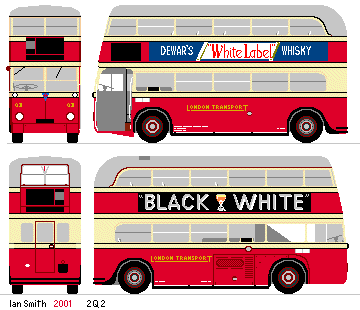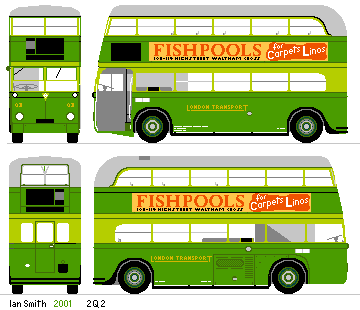
The LONDON TRANSPORT AEC Q classThis page created 7th January 2001, using Notepad, by Ian Smith.The 2Q2s: Central Area double-deckers, Q2-Q3London was not the first place to try double-decker Qs. AEC had a double-decker body built for a demonstrator in 1932, and this went for trials in Birmingham in January 1933. A preproduction batch of ten more went to Crosville (#1000), Bolton (#2), Hull (#127), Bradford (#393), Leeds (#65), Westcliff-on-Sea, Birkenhead (#185), and Newcastle-upon-Tyne (#156) with two to London Transport (Q2 and Q3). These were the 2Q2s.Construction
Chassis: AEC Q, 15ft 10in wheelbase, AEC A167 petrol engine, D129 gearbox
They had a wide front entrance ahead of the front wheels, with no door. The entrance platform extended across to the cab partition, and another step took passengers up into the lower saloon or to the foot of the stairs. These rose rearwards behind the driver, and curled up clockwise. A translucent panel gave light on the stairs without affording passers-by the opportunity to look up ladies skirts. (Not that the miniskirt had been invented yet, of course - but this was a design ahead of its time). Inside there were two bench seats: one for two over the nearside wheel-arch and one for four over the engine. plus eleven forward-facing pairs, giving 28 downstairs. Upstairs there were also only 28 seats, although more could have been fitted in. But they weighed 6tons 4cwt 2 qtrs, and the overall maximum loaded weight limit was just 10tons. Given the Q's odd weight distribution, perhaps LT didn't want to push its luck with the tilt test! An emergency exit door was fitted in the rear of the lower saloon, and an STL style exit window in the rear dome. The styling was quite "Birmingham" with three bands round the body, interrupted at front and back by maximum size triple-box displays. A via-points display was carried above the entrance, and route number stencil holders were behind the bench seats. Livery was red with a lot of cream, with plenty of black lining: what became known as "trolleybus livery".
Into serviceChiswick photographed them wearing blinds for the 77, and corresponding Chalk Farm plates, both before and after applying adverts. But they were destined to work neither there nor on that route. They both were allocated to Harrow Weald (HD) in July 1934. They started work on the 114 between Mill Hill and South Harrow: not a high-profile route. The 52, between Victoria and Mill Hill brought them into the centre once they were transferred to Middle Row (X), in January 1935. But the Central Area's enthusiasm for the type did not seem high. They were, on the other hand, well-pleased with their contemporary STL Regents.
In July 1938 all four moved to Hertford (HG) for use on the 310.
That lasted for a year, then all five Q double-deckers were moved to Grays (GY).
The war saw the retirement of all five into store at various places. Q3 was on the wrong end of military action in June 1941, while acting as a Home Guard Mobile Command Post at Swanley garage. It was damaged by a bomb. Chiswick assesed it as not worth repairing and scrapped it. Q2 was moved to the old AEC works in Walthamstow in January 1944, and remained there until the Ministry allowed its sale in March 1946.
It went with the other three double-deckers to Lancashire Motor Traders. Q2 was converted to a 31-seat single-decker for Lindon of Windle, near S.Helens, Lancashire. Later it became Lightfoot's snack-bar in Leicester. It was still providing service in 1951.
|
 In one of Michael Baker's books he comments that his school-mates likened the new RTs to the trolleybuses. The double-decker Q's bodied by Metro-Cammell were the inspiration for the body-shape of both, with the curving back front and the upright domed rear. (I even adapted my Q2 drawing from an RT drawing). So although they sold in penny numbers they had enormous influence on bus design in the middle of the twentieth century.
In one of Michael Baker's books he comments that his school-mates likened the new RTs to the trolleybuses. The double-decker Q's bodied by Metro-Cammell were the inspiration for the body-shape of both, with the curving back front and the upright domed rear. (I even adapted my Q2 drawing from an RT drawing). So although they sold in penny numbers they had enormous influence on bus design in the middle of the twentieth century.

 bus histories
bus histories Bus Stop
Bus Stop Q index.
Q index. 1Q1
1Q1 2Q2
2Q2